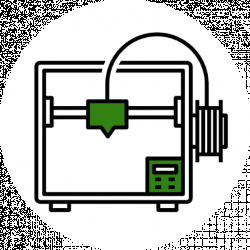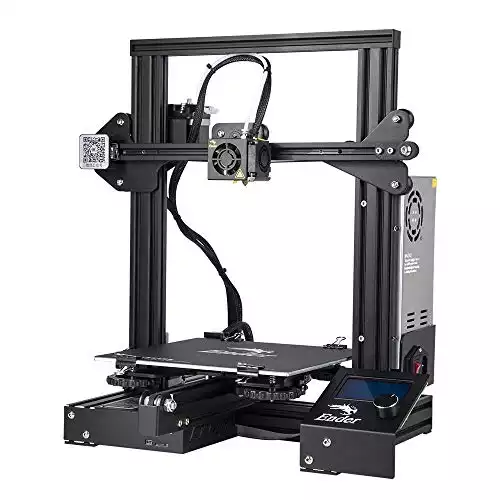- Creality Ender vs Anet A8 [2022]: Which is Better? - April 14, 2022
- TEVO Tornado Review [2022] All You Need To Know - April 6, 2022
- Anet A6 Review [2022 UPDATED Version] - April 5, 2022
The Prusa i3 and the Anet A8 are both DIY kits 3D printers, meaning that you will have to assemble them. Prusa i3 is one of the, if not the most famous 3D printer in the world, with the Anet A8 following it up.
The reason for their popularity is that they are both open source and very cheap for what they offer.
The Anet A8 is an open design with many clones, while the Prusa i3 does have an actual manufacturer where you can buy the original. Still, since it’s ALSO open-source, there are many open-source modifications online.
In the following sections, we will list the features of each 3D printer, available upgrades, as well as a comparison between the two, including a comparison of their features, their Pros, and Cons. At the very end, you will find the final summary and rating of each 3D printer respectively.
Bottom Line Up Front: Personally, I lean more towards the higher resolution and auto calibration of the Creality Prusa i3 MK3 available here.
For most users, I recommend starting with this Creality Ender 3 Prusa i3 model here. It produces more consistent quality prints and is MUCH easier to assemble, let alone being more affordable. A clear choice for me.
Core Features of the Prusa i3 3D Printer
- Print Volume: The Prusa i3 features a pretty big 9.84″ x 8.3″ x 8″ (250 x 210 x 200 mm) print area, providing most users with plenty of space to print big objects as well as print many smaller objects all at the same time.
- Resolution: Cheap printers usually have to compensate somewhere, but no this 3D printer. The Prusa i3 comes with a print resolution as high as 0.05mm or 50 microns, something that we are only used to see in very high-end 3D printers. That combined with the interchangeable 0.4mm nozzle makes for a very high quality capable 3D printer.
- Open source: This is probably its biggest advantage over other 3D printers on the market. Not only is the software open source, the hardware and all the control boards are also open source, allowing experienced users to take advantage of any modification and upgrades. Being so cheap and so popular has also caused a huge community to emerge, with thousands of people sharing tips and tricks as well as troubleshooting in online forums, ensuring that no matter what problems(if any) you face, someone will be able to help you.
- Material options: Again, being based on an open source design, and having a heated bed, almost any material can be printed using this printer. This is very important to note, as this is not a standard feature from budget 3D printers.
- Speed: As impressive as the high resolution is, this printer has another trick up its sleeve. It can print at a 100mm/sec rate. It’s not very often that we see such a high resolution alongside such a fast print speed. Of course, printing at such a speed will have a negative impact on the actual printed object.
- Auto Calibration: A budget 3D printer with automatic bed calibration? Yes, that is indeed the case here. The printer features an automatic 9 points XYZ / skew axes compensation calibration using a capacitive sensor on the print head.
- LCD screen: The Prusa i3 includes an LCD screen with a torary knob that allows for very fast changes to the printer settings and parameters. The included screen can also display the current printing stats, as well as allow tweaking of the printer while it is printing.
- Quality parts: Being a DIY kit, a lot of assembling has to be done. All the major parts and interconnects for the structural parts of the printer are high-quality plastics or aluminum, giving this printer an advantage in strength and rigidity over other DIY kits.
- Full Review: Prusa i3 MK3+ Review
Prusa i3 Key Specifications
- Printing Technology: FDM (Fused Deposition Modeling)
- Nozzle diameter: 0.4mm
- Nozzle temperature: 260 degree
- Product forming size: 9,84″ x 8,3″ x 8″ (250 x 210 x 200 mm)
- Layer thickness: 0,05 – 0,35 mm
- Memory card offline print: TF card
- Print speed: 100mm/s
- Supported filament material: ABS, HIPS, PLA, PETG etc.
- Material diameter: 1.75mm
- File format: G-code,STL
- XY-axis positioning accuracy: 0.012mm
- Z-axis positioning accuracy: 0.004mm
- Working Power: 100W
- Software: Cura
- Packing Type: unassembled packing
For most users, I recommend starting with this Creality Ender 3 Prusa i3 model here. It produces more consistent quality prints and is MUCH easier to assemble, let alone being more affordable. A clear choice for me.
Core Features of the Anet A8 3D Printer
- Print Volume: The Anet A8 features a very standard 8.6″ x 8.6″ x 9.4″ (220 x 220 x 240mm) print volume which is more than enough for most users, both new and experienced.
- Resolution: While this is a very cheap 3D printer, because of its open source philosophy, any nozzle size can be used, and everything can be further upgraded. As standard, this printer is able to print at a resolution as high as 0.1mm layer height, making for some very detailed prints. This can be achieved using the included 0.4mm nozzle
- Open source: This is probably its biggest advantage over other 3D printers on the market. Not only is the software open source, the hardware and all the control boards are also open source, allowing experienced users to take advantage of any modification and upgrades. Being so cheap and so popular has also caused a huge community to emerge, with thousands of people sharing tips and tricks as well as troubleshooting in online forums, ensuring that no matter what problems(if any) you face, someone will be able to help you.
- Material options: Again, being based on an open source design, and having a heated bed, almost any material can be printed using this printer. This is very important to note, as this is not a standard feature from budget 3D printers.
- LCD screen: The Anet A8 includes an LCD screen with a keypad that allows for changes to the printer settings and parameters. The included screen can also display the current printing stats, as well as allow tweaking of the printer while it is printing.
- 3D printed parts: Being a DIY kit, a lot of assembling has to be done. All the major parts are black, pre-cut acrylic pieces and every interconnect and moving parts are 3D printed, meaning they printer can print replacements for itself.
- Full Review: Anet A8 Review
Anet A8 Key Specifications
- Printing Technology: FDM (Fused Deposition Modeling)
- Nozzle diameter: 0.4mm
- Nozzle temperature: Room temperature to 260 degree
- Product forming size: 220 x 220 x 240mm
- Layer thickness: 0.1-0.3mm
- Memory card offline print: TF card
- Print speed: 40 – 120mm/s
- Supporting material: ABS, HIPS, PLA, PETG etc.
- Material diameter: 1.75mm
- Language: Chinese, English, French, German, Spanish
- File format: G-code, STL=
- XY-axis positioning accuracy: 0.012mm
- Z-axis positioning accuracy: 0.004mm
- Working Power: 150W
- Software: Cura
- Packing Type: unassembled packing
Comparison Prusa i3 vs Anet A8
- Hardware: These printers look very similar but they are not. The A8 is mostly made from open source, off the shelf hardware and laser cut acrylic parts. The i3 takes it a bit further, using aluminum parts where structural support is needed and generally using higher quality parts such as motors and mainboards.
- Design: The design of the printers is also very similar but have some small differences. One of the main differences is the filament spool holder. The A8 has the spool of filament just sitting next to the printer, while the i3 has support for a filament holder, as well as a tube channel to guide the filament away from the printer, but without causing any disturbances while printing.
- Performance: This is where we see the biggest differences between the two 3D printers. The Prusa i3 is just a better-developed printer. It offers very high-quality prints as well as speedy prints. Both printers have a heated bed which makes them capable of printing almost any material. The Anet A8 is a good performer, but can not reach the detail level of the i3. Another big advantage of the Prusa i3 is the automatic calibration of the print bed, something that the A8 lacks but can be implemented, since it is, after all, an open source 3D printer.
- Community: Both 3D printers have huge communities online regarding performance issues, troubleshooting, upgrades as well as general tips and tricks. The Anet A8 is used mostly by amateurs for fast prototype prints while the Prusa i3 can be seen used for more serious projects, where stability and quality are desired.
- Assembly: Since these 3D printers come in parts and require an assembly, it is important to know that the Prusa i3 comes with an easier assembly process than the Anet A8, but because of all the user support around these printers, many written, as well as video guides with a lot of details, can be found online. There is also the possibility to buy a pre-assembled Prusa i3, but that will cost more
- Price: This is probably one of the strongest points of why these 3D printers are so popular. The Anet A8 costs just 239.99 and while the Prusa i3 costs $155. We can now see why the Prusa can afford to have more bells and whistles, like autocalibration and very high resolution.
Conclusion: Anet A8 or Prusa i3?
Both 3D printers are capable of producing very high-quality prints and can be a fun way for anyone to get into the DIY world by assembling a kit like these. There are no other printers on the market as such a low cost that offer so much.
My Bottom Line: The Prusa i3 available here is more expensive than the Anet A8, but the difference in resolution and the addition of auto calibration might just be worth it for some.
For most users, I recommend starting with this Creality Ender 3 Prusa i3 model here. It produces more consistent quality prints and is MUCH easier to assemble, let alone being more affordable. A clear choice for me.
Further Research:
If you are still on the fence, consider these resources for further guidance:

![Prusa i3 vs Anet A8 [Jul 2022]: Which is Better?](https://total3dprinting.org/wp-content/uploads/2018/02/Add-heading-31.png.webp)


Ben
Friday 20th of September 2019
You accidentally swapped the layer thickness of the two printers. The Prusa i3 Layer thickness is 0,05 – 0,35 mm.